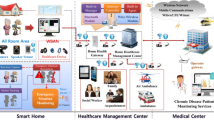Abstract
Today, the internet of things (IoT) is becoming more common and finds applications in several domains, especially in the healthcare sector. Due to the rising demands of IoT, a massive quantity of sensing data gets generated from diverse sensing devices. Artificial intelligence (AI) techniques are vital for providing a scalable and precise analysis of data in real time. But the design and development of a useful big data analysis technique face a few challenges, like centralized architecture, security, and privacy, resource constraints, and the lack of adequate training data. On the other hand, the rising blockchain technology offers a decentralized architecture. It enables secure sharing of data and resources to the different nodes of the IoT network and is promoted for removing centralized control and resolving the problems of AI. This study develops an optimal deep-learning-based secure blockchain (ODLSB) enabled intelligent IoT and healthcare diagnosis model. The proposed model involves three major processes: secure transaction, hash value encryption, and medical diagnosis. The ODLSB technique comprises the orthogonal particle swarm optimization (OPSO) algorithm for the secret sharing of medical images. In addition, the hash value encryption process takes place using neighborhood indexing sequence (NIS) algorithm. At last, the optimal deep neural network (ODNN) is applied as a classification model to diagnose the diseases. The utilization of OPSO algorithm for secret sharing and optimal parameter tuning process shows the novelty of the work. We carried out detailed experiments to validate the outcome of the proposed method, and several aspects of the results are considered. At the time of the diagnosis process, the OPSO-DNN model has yielded superior results, with the highest sensitivity (92.75%), specificity (91.42%), and accuracy (93.68%).










Similar content being viewed by others
References
Dwivedi AD, Srivastava G, Dhar S, Singh R (2019) A decentralized privacy-preserving healthcare blockchain for IoT. Sensors 19(2):326
Abdolkhani R, Gray K, Borda R, DeSouza R (2019) Patient-generated health data management and quality challenges in remote patient monitoring. JAMIA Open 2(4):471–478
Uddin MA, Stranieri A, Gondal I, Balasubramanian V (2018) Continuous patient monitoring with a patient centric agent: A block architecture. IEEE Access 6:32700–32726
Uddin MA, Stranieri A, Gondal I (2018) Balasubramanian, A patient agent to manage blockchains for remote patient monitoring. Stud Health Technol Inform 254:105–115
Tuli S, Mahmud R, Tuli S, Buyya R (2018) Fogbus: A Blockchain-Based Lightweight Framework for Edge and Fog Computing. J SystSoftw 154:22–36
Salah K, Rehman MHU, Nizamuddin N, Al-Fuqaha A (2017) Blockchain for AI: review and open research challenges. IEEE Access 7:10127–10149. https://doi.org/10.1109/ACCESS.2018.2890507
Y. Yuan, F.Y. Wang, Towards blockchain-based intelligent transportation systems, in: 2016 IEEE 19th International Conference on Intelligent Transportation Systems, ITSC, IEEE, 2016, pp. 2663–2668, https://doi.org/10.1109/ITSC.2016.7795984
Atzori L, Jera A, Morabito G (2010) The internet of things: A survey. ComputNetw 54(15):2787–2805. https://doi.org/10.1016/j.comnet.2010.05.010
Rahman MA, Hossain MS, Loukas G, Hassanain E, Rahman SS, Alhamid MF, Guizani M (2018) Blockchain-based mobile edge computing framework for secure therapy applications. IEEE Access 6:72469–72478
Griggs KN, Ossipova O, Kohlios CP, Baccarini AN, Howson EA, Hayajneh T (2018) Healthcare blockchain system using smart contracts for secure automated remote patient monitoring. J Med Syst 42(7):130
Tariq N, Qamar A (2020) Muhammad Asim and FarrukhAslam Khan, “Blockchain and Smart Healthcare Security: A Survey.” ProcediaComputSci 175:615–620
Chen Y, Ding S, Xu Z, Zheng H, Yang S (2019) Blockchain-based medical records secure storage and medical service framework. J Med Syst 43(1):5
Sahay R, Geethakumari G, Mitra B (2020) A novel blockchain based framework to secure IoT-LLNs against routing attacks. Computing 102:2445–2470
X. Liang, J. Zhao, S. Shetty, J. Liu, D. Li, Integrating blockchain for data sharing and collaboration in mobile healthcare applications, in: Proceedings of the 28th IEEE Annual International Symposium on Personal, Indoor, and Mobile Radio Communications (PIMRC), 2017, pp. 1–5, doi:https://doi.org/10.1109/PIMRC.2017.8292361
Zhang P, White J, Schmidt DC, Lenz G, Rosenbloom ST (2018) Fhirchain: applying blockchain to securely and scalably share clinical data. ComputStructBiotechnol J 16:267–278
Brogan J, Baskaran I, Ramachandran N (2018) Authenticating health activity data using distributed ledger technologies. ComputStructBiotechnol J 16:257–266
Gordon WJ, Catalini C (2018) Blockchain technology for healthcare: facilitating the transition to patient-driven interoperability. ComputStructBiotechnol J 16:224–230
T. Rupasinghe, F. Burstein, C. Rudolph, S. Strange, Towards a blockchain based fall prediction model for aged care, in: Proceedings of the Australasian Computer Science Week Multiconference, ACM, 2019, p. 32
Dorri A, Kanhere SS, Jurdak R (2017) Towards an optimized blockchain for IoT, IoTDI '17: proceedings of the second international conference on internet-of-things design and implementation, ACM, pp 173–178. https://doi.org/10.1145/3054977.3055003
E. Gaetani, L. Aniello, R. Baldoni, F. Lombardi, A. Margheri, V. Sassone, Blockchain-based database to ensure data integrity in cloud computing environments, in: Italian Conference on Cybersecurity, Venice, Italy. 17 – 20 Jan 2017, 2017, p. 10
Novo O (2018) Blockchain meets IoT: An architecture for scalable access management in IoT. IEEE Internet of Things J 5(2):1184–1195
Uthayakumar J, Vengattaraman T, Dhavachelvan P (2019) A new lossless neighborhood indexing sequence (NIS) algorithm for data compression in wireless sensor networks. Ad Hoc Netw 83:149–157
Acknowledgements
The work of K. Shankar was supported by RUSA Phase 2.0 Grant Sanctioned Vide Letter No. F. 24-51/2014-U, Policy (TNMulti-Gen), Department of Education, Government of India, in October 2018.
Author information
Authors and Affiliations
Corresponding author
Ethics declarations
Conflict of interest
The authors declare that they have no conflict of interest. The manuscript was written through contributions of all authors. All authors have given approval to the final version of the manuscript.
Additional information
Publisher's Note
Springer Nature remains neutral with regard to jurisdictional claims in published maps and institutional affiliations.
Rights and permissions
About this article
Cite this article
Veeramakali, T., Siva, R., Sivakumar, B. et al. An intelligent internet of things-based secure healthcare framework using blockchain technology with an optimal deep learning model. J Supercomput 77, 9576–9596 (2021). https://doi.org/10.1007/s11227-021-03637-3
Accepted:
Published:
Issue Date:
DOI: https://doi.org/10.1007/s11227-021-03637-3




